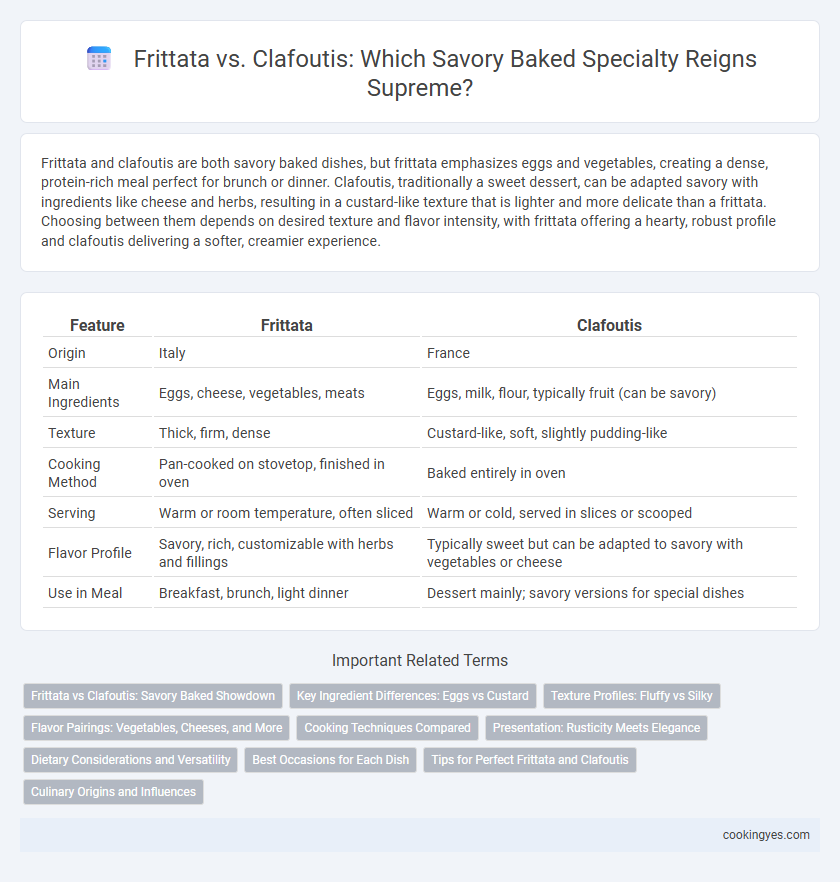Frittata and clafoutis are both savory baked dishes, but frittata emphasizes eggs and vegetables, creating a dense, protein-rich meal perfect for brunch or dinner. Clafoutis, traditionally a sweet dessert, can be adapted savory with ingredients like cheese and herbs, resulting in a custard-like texture that is lighter and more delicate than a frittata. Choosing between them depends on desired texture and flavor intensity, with frittata offering a hearty, robust profile and clafoutis delivering a softer, creamier experience.
Table of Comparison
| Feature | Frittata | Clafoutis |
|---|---|---|
| Origin | Italy | France |
| Main Ingredients | Eggs, cheese, vegetables, meats | Eggs, milk, flour, typically fruit (can be savory) |
| Texture | Thick, firm, dense | Custard-like, soft, slightly pudding-like |
| Cooking Method | Pan-cooked on stovetop, finished in oven | Baked entirely in oven |
| Serving | Warm or room temperature, often sliced | Warm or cold, served in slices or scooped |
| Flavor Profile | Savory, rich, customizable with herbs and fillings | Typically sweet but can be adapted to savory with vegetables or cheese |
| Use in Meal | Breakfast, brunch, light dinner | Dessert mainly; savory versions for special dishes |
Frittata vs Clafoutis: Savory Baked Showdown
Frittatas and clafoutis both serve as versatile savory baked dishes but differ significantly in texture and ingredients. Frittatas rely on eggs combined with vegetables, cheeses, and meats, resulting in a dense, protein-rich dish, while clafoutis features a thinner batter similar to pancake mix with less egg content, producing a lighter, custard-like texture. The choice between frittata and clafoutis hinges on preferred mouthfeel and ingredient emphasis, with frittatas offering more substantial fillings and clafoutis presenting a delicate balance of sweet and savory flavors.
Key Ingredient Differences: Eggs vs Custard
Frittatas rely on whole eggs beaten and cooked to create a firm, protein-rich base often mixed with vegetables, cheese, or meats, emphasizing a savory, fluffy texture. Clafoutis uses a custard-like batter made from eggs blended with milk or cream and flour, resulting in a lighter, custardy consistency that typically balances sweet or savory ingredients. The primary distinction lies in the frittata's egg-centric structure versus the clafoutis' flour-thickened custard base affecting texture and density.
Texture Profiles: Fluffy vs Silky
Frittata features a fluffy texture achieved by beating eggs thoroughly and cooking gently, creating a light and airy structure ideal for incorporating vegetables and cheeses. Clafoutis, traditionally a fruit dessert, when adapted for savory dishes, offers a silky, custard-like consistency due to the higher ratio of liquid ingredients and baking technique. Choosing between these baked specialties depends on whether a soft, creamy mouthfeel or a firm, airy bite is preferred.
Flavor Pairings: Vegetables, Cheeses, and More
Frittatas excel with robust flavor pairings such as sauteed spinach, mushrooms, sharp cheddar, and fresh herbs like basil or thyme, enhancing their rich, egg-based texture. Clafoutis, while traditionally sweet, adapts to savory versions featuring lighter, creamier cheeses like ricotta or goat cheese, paired with delicate vegetables such as zucchini, cherry tomatoes, and fresh thyme. Both dishes benefit from complementary ingredients, but frittatas emphasize bold, savory components, whereas savory clafoutis highlight subtle, creamy flavors for a unique baked specialty experience.
Cooking Techniques Compared
Frittata and clafoutis differ significantly in their cooking techniques for savory baked dishes. Frittata is cooked slowly on the stovetop before finishing in the oven, resulting in a dense, firm texture with caramelized edges. Clafoutis involves pouring a thin batter over ingredients and baking entirely in the oven, producing a custard-like consistency that is lighter and more delicate.
Presentation: Rusticity Meets Elegance
Frittata showcases a rustic charm with its open-faced, golden-brown surface and visible vegetable and cheese textures, embodying a hearty, home-cooked appeal. Clafoutis, while traditionally sweet, transforms into an elegant savory dish with its smooth, custard-like interior and neatly baked edges, offering a refined presentation. This contrast highlights frittata's robust, casual appeal against clafoutis' delicate, polished finish in savory baked specialties.
Dietary Considerations and Versatility
Frittatas offer a high-protein, low-carb option ideal for keto and paleo diets, while clafoutis often includes flour and is more carb-heavy, affecting gluten-sensitive individuals. Frittata's flexibility allows incorporation of diverse vegetables, cheeses, and meats, catering to various dietary restrictions like vegetarian or dairy-free when customized. Clafoutis, traditionally sweet, can be adapted for savory variations but lacks the same breadth of ingredient versatility and dietary accommodation as a frittata.
Best Occasions for Each Dish
Frittata, rich in eggs, vegetables, and cheese, is ideal for brunches, casual lunches, or potlucks where hearty, protein-packed dishes are favored. Clafoutis, traditionally a sweet French baked custard, can be adapted for savory versions with vegetables or herbs, making it perfect for elegant dinners or special occasions that call for refined yet comforting recipes. Each dish's texture and flavor profile suit distinct occasions, with frittata offering a robust, versatile option and clafoutis providing a delicate, custardy alternative.
Tips for Perfect Frittata and Clafoutis
For a perfect frittata, use a mix of beaten eggs and cream for a creamy texture, and cook slowly over low heat to avoid browning while ensuring even cooking. In contrast, clafoutis batter should be thinner, similar to pancake batter, with flour and milk balancing the eggs for a delicate, custard-like consistency. Both dishes benefit from preheating the oven and allowing the base to set before finishing in the oven to achieve optimal texture and flavor.
Culinary Origins and Influences
Frittata, rooted in Italian culinary tradition, is a versatile egg-based dish enriched with diverse ingredients like vegetables, meats, and cheeses, emphasizing savory flavors from Mediterranean influences. Clafoutis, traditionally a French dessert originating from the Limousin region, typically features a flan-like batter baked with fruits, though savory variations exist with ingredients such as vegetables or cheese but remain less common. The distinct cultural origins shape their preparation: frittata highlights an open-faced omelet style linked to rustic Italian home cooking, while clafoutis reflects French baking techniques blending custard and fruit or savory components.
Frittata vs Clafoutis for savory baked specialties Infographic

 cookingyes.com
cookingyes.com